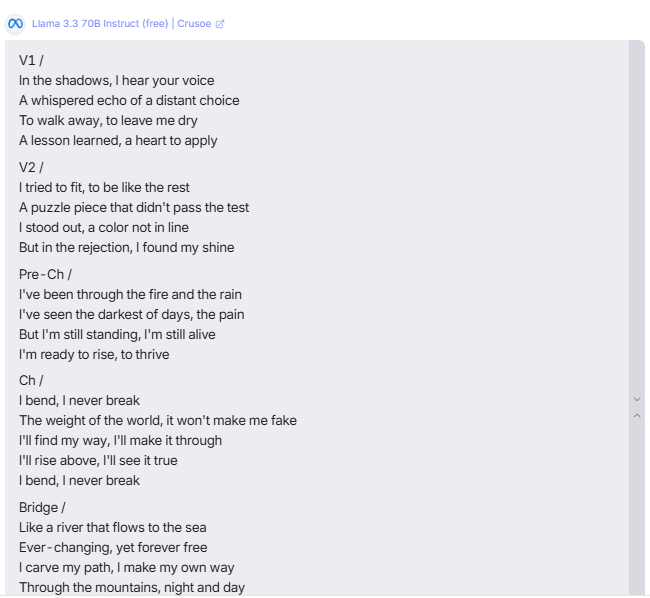
Meta’s Llama 3.3 continues the open‑weights tradition with a 130 K context window and balanced performance that nudges past the closed‑source pack in fiction quality.
Up four spots to #19, Llama 3.3 stays a favorite for uncensored, fine‑tunable storytelling—while costing just $0.72 per million tokens in or out.
Ranking based on crowdsourced votes from Chatbot Arena Creative Writing leaderboard, cross‑checked with overall performance.
130000 tokens
Weights released under Meta Llama 3 License
Safety filters can be relaxed in self‑hosted inference
2024‑10
Style Comment:
Write English lyrics for a mid-tempo pop song (≈ 100 BPM) in ABAB CB structure (two verses, pre-chorus, chorus, bridge, final chorus).
Theme: personal resilience after social rejection.
Requirements
• Chorus must contain the hook line “I bend, I never break.”
• Bridge should introduce a fresh metaphor and shift the rhyme scheme.
• Avoid explicit profanity; keep radio-friendly.
• Deliver as: V1 / V2 / Pre-Ch / Ch / Bridge / Ch. Only the lyrics, no chords.
Style Comment:
Compose a Shakespearean sonnet (14 lines, iambic pentameter, abab cdcd efef gg) on the tension between digital memory and human forgetting. Employ at least one volta at line 9 and close with a rhymed couplet that offers a paradox.
Style Comment:
Write a 1 000-word SEO-optimized blog article aimed at first-time home coffee-roasters.
Requirements
Style Comment:
Write high-conversion landing-page copy (≈ 300 words) for a new line of lightweight, fully recyclable running shoes named Zephyr-Lite™.
Audience → urban runners, ages 20-40, eco-conscious but style-driven.
Must include
• A punchy headline (≤ 8 words)
• Sub-headline elaborating the core benefit (≤ 18 words)
• 3 scannable benefit bullets (2-3 lines each)
• One short customer testimonial (first name, city)
• A single CTA button label (≤ 4 words)
Tone: energetic, conversational, modern.
Style Comment:
Write an 800-word argumentative essay assessing whether universal basic income (UBI) would stimulate entrepreneurship in developed economies.
Requirements
• Present a clear thesis in the introduction.
• Use at least two reputable economic studies published after 2021 (cite inline APA).
• Address one major counterargument.
• Conclude with a policy recommendation.
• Formal academic tone, but readable. Return only the essay text.
Style Comment:
Generate a structured mini-literature review (≈ 1 000 words) on the latest (2022-2025) CRISPR-based therapies for sickle-cell disease.
Deliver as:
Cite sources in IEEE style; include DOI where available. Output only the review.
Llama 3.3 writes gently introspective prose with solid science metaphors; lyrical cohesion dips in tight‑rhyme poetry.
Ideal for full codebase or multi‑chapter novel workflows without truncation.
QLoRA & LoRA adapters allow domain specialization on consumer GPUs.
$0.72/M tokens in or out—simple to forecast spend.
Meta lists flat rates of $0.72 per million tokens for both input and output—competitive among open‑source cloud endpoints.
No tiered discounts announced as of May 2025.
Need more context or enterprise support?
Best for: Book‑length RAG or tool‑use agents
256 K context and agent‑tuned tooling.
Read ReviewBest for: Premium assistant scenarios
128 K context closed‑source leader with multimodal IO.
Read ReviewWeights are freely downloadable under Meta’s community license—commercial use allowed except for companies over 700 M MAU.
130 K tokens per request.
No. Llama 3.3 is text‑only; you’ll need adapters for multimodal.
Flat $0.72 per million tokens for both prompts and completions, billed to the nearest 1 K tokens.
Yes—unless your products exceed 700 M monthly active users, in which case you must request an additional license.
If you want affordable, sizable context with community tooling, Llama 3.3 is an easy pick—just watch paragraph length and poetic meter.